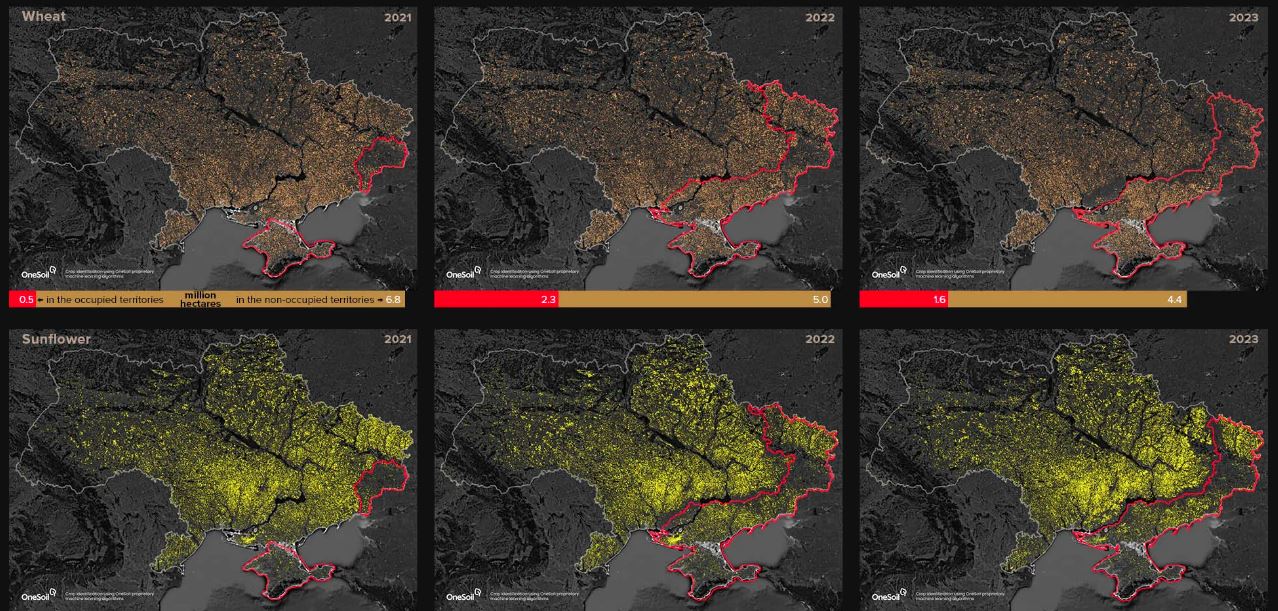Since invading Ukraine in February 2022, Russia has seized control of prime grain-growing territories in the southern oblasts of Kherson and Zaporizhzhia. A new report from independent Ukrainian media outlet Texty, in partnership with agritech firm OneSoil, estimates that Russia has plundered as much as 15 million metric tons of grain from these occupied lands over the past two years.
OneSoil's satellite data shows over 6.4 million tons of wheat alone was likely harvested from occupied Ukrainian fields in 2022 – more than the entire annual wheat output of Romania. Even with shrunken planting areas and drought-depressed yields due to damaged irrigation infrastructure, Russia is accused of robbing Ukraine of enough food staples to feed millions worldwide.
Notably, the crops are sown at a distance from the frontline, where Russians have erected fortifications, as seen from the images below. As well, in the Orikhiv district, the occupiers even banned the sowing of tall crops such as sunflower and maize, likely fearing they may camouflage Ukraine's advancing soldiers.

The report describes a pattern of Russian forces confiscating or purchasing Ukrainian farmers' grain stockpiles for a fraction of their value in spring 2022, as troops advanced deeper into Kherson and Zaporizhzhia oblasts at the war's start.
"Security officials estimate Russia extorted up to 70% of the 2022 grain harvest from farmers under occupation," Texty writes.
Satellite images reveal the likely destination of much of this plundered grain: Crimean seaports now busy exporting stolen goods abroad. Photos show convoys of grain-laden trucks and train cars queued up around the clock near grain terminals in Sevastopol and Kerch, where stolen Ukrainian grain is shipped off and sold internationally.
Observers say the well-connected networks of Russian grain buyers in annexed Crimea, plus the peninsula's greater port capacity, facilitate siphoning Ukrainian crops across the Black Sea to Russia-friendly markets. Grain truck driver job ads for positions in Crimea have proliferated, according to the report.
The report acknowledges Russia has had limited grain export capacity in occupied ports like Berdiansk and Mariupol compared to well-established Crimean routes. However, it notes Russian attempts to expand shipping from these southeastern cities. Claims of a "first grain ship" leaving Mariupol in early 2023 shed little light on actual volumes moved. Occupation authorities are estimated exporting around 111,000 tons of grain through Mariupol as of October 2022 – a fraction of the 2.3 million tons shipped through the bombed-out port in the year before invasion.
The report explains that Ukrainian farmers trapped under occupation have had to sell their crops for a pittance to Russian buyers. Prices offered were sometimes as low as 10% of retail value.
Texty estimates Russia may have generated over $5 billion total by exporting occupied territories' grain harvests of 2021, 2022, and 2023. This calculation is based on crop area and yield data cross-referenced with historical export pricing from the Moscow Stock Exchange.
Even if not directly padding state budgets, these massive grain sales still enrich and sustain Russia's crumbling economy "by covering logistics costs, salaries and simply enriching Russians engaged in the supply chain," Texty says.
Russia's theft of Ukraine's crops may constitute a war crime, lawyers from the international law firm Global Rights Compliance said in a recent report:
Russia’s “unprecedented” Ukrainian grain theft premeditated war crime, legal report suggests





